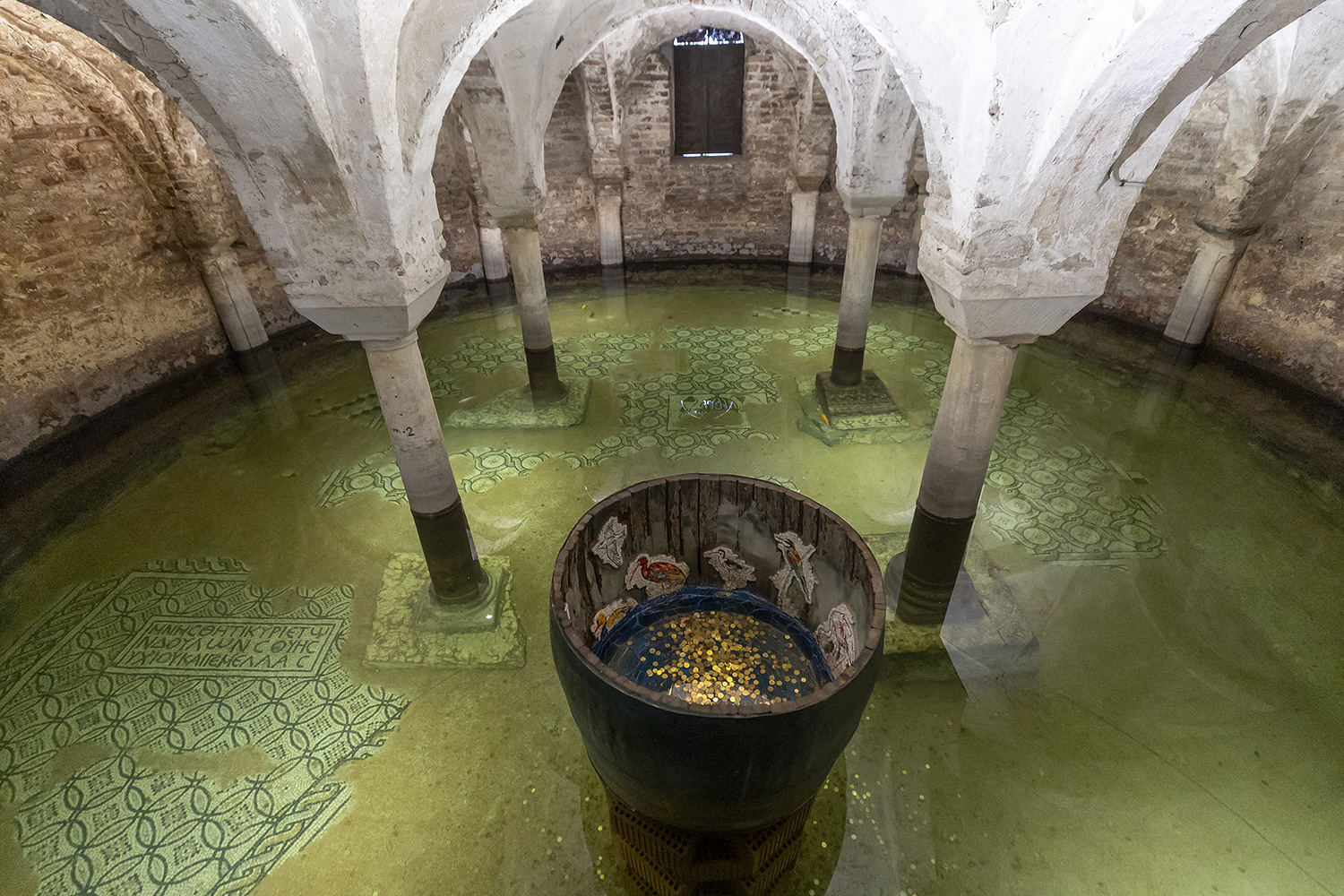Pialassa
2023 | flooded Crypt of San Francesco, Ravenna
80x95x95cm
direct technique on cement, wooden, metal and fiberglass, hunting barrels, waste and stocks of enamels and marbles, cement glue, blue
cement grout, binoculars
curated by Arianna Maestrale (Mixta)
in collaboration with Koko Mosaico








©️MAR-Museo d’Arte della città di Ravenna, ph. Fabrizio Zani
[…] The State will encourage natural and legal persons, as well as communities, to protect nature, and will promo- te respect for all the elements forming an ecosystem.”
article 71, Rights of Nature, Chapter 7 of the 2008 Constitution of Ecuador
‘Pialassa’, a work by Rebecca Sforzani, is part of a large project that the artist designed for several residencies in different locations, and is related to the introduction of nature as a subject of law in the 2008 Constitution of Ecuador. The mosaic, which was designed by the artist during her stay in Ravenna and realised with the precious collaboration of the workshop Koko Mosaico by Arianna Gallo, depicts a median environment between water and sky, which is inhabited by a number of bird species (flamingo, black-winged stilt, whiskered tern, red heron, spoonbill, ferruginous duck, glossy ibis, kingfisher, bee-eater), represented according to an iconographic cross-reference between the figures from birdwatching manuals and the traditional mosaics of Ravenna, from which was taken for example the use of gold for water reflections.
During her stay in the city, the artist studied the relationship between human beings and nature, based on the specificity of the ter- ritory of Ravenna: guided by experts, she delved into the history and naturalistic aspects of the San Vitale pine forest and Pialassa Baiona, places that stimulated her research as they strongly represent the identity of Ravenna. The ‘pialasse’ are large brackish lagoons connecting the pine forest to the sea. Their name comes from the dialectal form ‘pia e laza’, which describes the continuous change of tides. The unstable relationship between water and land and their ever-precarious balance gave rise to the extraordinary biodiversity of the Po Delta area, with a changing landscape in which woods, pine forests and flooded forests alternate with freshwater and sal- twater wetlands. Thanks to this biodiversity, both today and at the time of the Byzantine Empire, it is possible to encounter many bird species, even very rare ones, most of which are depicted in the mosaics of the main monuments of Ravenna, including the Archbishop’s or St Andrew’s chapel, whose barrel vault represented a great reference for the work.
While strolling through the San Vitale pine forest, the artist found a hunting cartridge and some signs indicating ‘no vagrant hunting’, thus discovering that other types of hunting, such as stalking, were allowed. While it is well known that the ‘pialasse’ host a diverse and remarkable ecosystem, it is less known that there are several atolls that in the autumn are used by hunters as special ‘hunting barrels’ above the water. At the end of the hunting season, it is precisely in the same barrels that several bird species build their nests. Rebecca Sforzani’s work develops from this contradiction, addressing the encounter/clash between human being and nature from a Ravenna perspective, therefore in relation to lake environment, water birds and their habitat.
The installation, as a consequence, consists of a hunting barrel, which was originally a wine barrel, whose interior walls are mosaic-co-
vered with images of bird species, some of which are rare, that have been populating the Po Delta for years. Placed on the ancient floor of the presbytery, in the centre of the crypt of the Basilica of St. Peter Major in St. Francis, the work can be seen by the public from the small window under the high altar. The installation can be also observed through binoculars, which represent a reference both to the practice of hunting in the barrel, thus personifying the spectator in the hunter, and to the practice of birdwatching, which is widespre- ad in the Po Delta Park and in the Ravenna plains. By simply resting on the floor of the presbytery, and being naturally subject to the variation of the phreatic zone, just like in the ‘pialasse’ where the water ‘comes and goes’, the work is itself the result of a coming and going of situations. As a matter of fact, it is the artist’s practice to use discarded materials and find elements through relationships with people: the barrel used was given to her by two hunters from Ravenna, while the tesserae of the mosaic are made with leftovers from the Koko Mosaico workshop and unsold stock from an industrial mosaic factory (Ravennae). In addition, the conception of the work itself was developed on the basis of the various people met and interviewed by the artist during her visit: townspeople, the park ranger from the Ravenna Pinewood Nature Reserve, experts from the NatuRa Museum and the MAR Art Museum in Ravenna, and from the mosaic workshop.
Ultimately, it is a work that investigates contrasts and contradictions, not only between the inside and the outside, as it is suggested by the shape of the barrel, but also between life and death, between human being and nature. When reflecting on the specific issue of the barrel, which is used both for hunting and for nesting by the birds, a strong ambivalence between these opposites is called into question. It communicates how nature and culture are intertwined, often resulting in the interference of one with the other and vice versa.
This communication happens through the mosaic technique, which certainly more than other figurative media holds the magic of a strong ambivalence: the one between two-dimensionality and depth of the surface.
Critical text by Arianna Maestrale (Mixta)


























Photo credits: Arianna Gallo, Marco Vidale